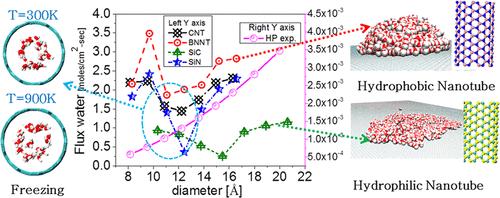当前位置:
X-MOL 学术
›
ACS Appl. Nano Mater.
›
论文详情
Our official English website, www.x-mol.net, welcomes your feedback! (Note: you will need to create a separate account there.)
Studies on Continuum Breakdown and Water Transport Behavior of Nanotubes for Water Purification: Impact of Temperature, Nanotube Material, and Diameter
ACS Applied Nano Materials ( IF 5.9 ) Pub Date : 2024-04-15 , DOI: 10.1021/acsanm.4c00729 Pooja Sahu 1, 2 , Sk. Musharaf Ali 1, 2
ACS Applied Nano Materials ( IF 5.9 ) Pub Date : 2024-04-15 , DOI: 10.1021/acsanm.4c00729 Pooja Sahu 1, 2 , Sk. Musharaf Ali 1, 2
Affiliation

|
The present studies shed light on the continuum breakdown of water confined in nanotubes of different materials and diameters. The structure and hydrodynamics of water confined in nanotubes of carbon (CNT), boron nitride (BNNT), silicon carbide (SiC), and silicon nitride (SiNT) of different chirality indices were analyzed to examine the potential nanomembrane material for water purification. According to our findings of the contact angle with water, BNNTs are more hydrophobic than CNTs, and silica nanotubes are hydrophilic. The higher permeability of water was observed through CNTs and BNNTs in comparison to silica nanotubes. Nearly flat velocity profiles indicated continuum breakdown at the nanoscale. Also, the trend for viscosity and diffusion coefficient did not follow the Stokes–Einstein relation, indicating continuum breakdown. The results demonstrated the connectivity of microscopic diffusion with the macroscopic permeation flux, which might be important information for the theoretical investigation of the suitable operational regime in reverse osmosis. Essentially, the continuum breakdown due to freezing of water was seen to be diminished with an increase in temperature. The results showed characteristic changes in the density profile, diffusion coefficient, velocity autocorrelation functions, density of state functions, and thermodynamic entropic components (evaluated using the two-phase thermodynamic method) of permeating water molecules. Importantly, our results reflect that the continuum breakdown observed for water confined in smaller nanotubes is true only at temperatures below 400 K due to the ice-like dense structure of water molecules. Once the entering water molecules can gain energy to compensate for the loss of H bonds, the conventional fluid dynamics relations can be well applied to estimate the hydrodynamics of confined water.
中文翻译:

用于净水的纳米管连续击穿和水传输行为的研究:温度、纳米管材料和直径的影响
目前的研究揭示了限制在不同材料和直径的纳米管中的水的连续分解。分析了不同手性指数的碳(CNT)、氮化硼(BNNT)、碳化硅(SiC)和氮化硅(SiNT)纳米管中水的结构和流体动力学,以研究用于水净化的潜在纳米膜材料。根据我们对水接触角的研究结果,BNNT 比 CNT 更具疏水性,而二氧化硅纳米管则具有亲水性。与二氧化硅纳米管相比,CNT 和 BNNT 具有更高的水渗透性。几乎平坦的速度分布表明纳米级的连续击穿。此外,粘度和扩散系数的趋势并不遵循斯托克斯-爱因斯坦关系,表明连续介质被破坏。结果证明了微观扩散与宏观渗透通量的连通性,这可能是反渗透中合适操作方案的理论研究的重要信息。本质上,由于水结冰而导致的连续体破坏随着温度的升高而减少。结果显示渗透水分子的密度分布、扩散系数、速度自相关函数、状态函数密度和热力学熵分量(使用两相热力学方法评估)的特征变化。重要的是,我们的结果反映出,由于水分子的冰状致密结构,观察到的限制在较小纳米管中的水的连续击穿仅在低于 400 K 的温度下才成立。一旦进入的水分子能够获得能量来补偿氢键的损失,传统的流体动力学关系就可以很好地应用于估计承压水的流体动力学。
更新日期:2024-04-15
中文翻译:

用于净水的纳米管连续击穿和水传输行为的研究:温度、纳米管材料和直径的影响
目前的研究揭示了限制在不同材料和直径的纳米管中的水的连续分解。分析了不同手性指数的碳(CNT)、氮化硼(BNNT)、碳化硅(SiC)和氮化硅(SiNT)纳米管中水的结构和流体动力学,以研究用于水净化的潜在纳米膜材料。根据我们对水接触角的研究结果,BNNT 比 CNT 更具疏水性,而二氧化硅纳米管则具有亲水性。与二氧化硅纳米管相比,CNT 和 BNNT 具有更高的水渗透性。几乎平坦的速度分布表明纳米级的连续击穿。此外,粘度和扩散系数的趋势并不遵循斯托克斯-爱因斯坦关系,表明连续介质被破坏。结果证明了微观扩散与宏观渗透通量的连通性,这可能是反渗透中合适操作方案的理论研究的重要信息。本质上,由于水结冰而导致的连续体破坏随着温度的升高而减少。结果显示渗透水分子的密度分布、扩散系数、速度自相关函数、状态函数密度和热力学熵分量(使用两相热力学方法评估)的特征变化。重要的是,我们的结果反映出,由于水分子的冰状致密结构,观察到的限制在较小纳米管中的水的连续击穿仅在低于 400 K 的温度下才成立。一旦进入的水分子能够获得能量来补偿氢键的损失,传统的流体动力学关系就可以很好地应用于估计承压水的流体动力学。



























 京公网安备 11010802027423号
京公网安备 11010802027423号